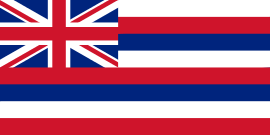Hawaii Consolidated Railway
 | |
| Locale | Hilo and vicinity on the island of Hawaiʻi |
|---|---|
| Dates of operation | 1899–1946 |
| Track gauge | 4 ft 8 1⁄2 in (1,435 mm) standard gauge |
| Headquarters | Hilo, Hawaii |
The Hawaii Consolidated Railway (HCR), originally named the Hilo Railway, was a standard gauge common carrier railroad that served much of the east coast of the island of Hawaiʻi (The Big Island) until an important section of the line was destroyed by a tsunami on April 1, 1946.
Origin
Like the Oahu Railway and Land Company (OR&L), the HCR grew out of a necessity for good transportation (mainly for sugarcane plantations) at the turn of the 20th century. Though not the first railroad on the Big Island, it was certainly the most ambitious. Its principal backer was Benjamin Dillingham, the businessman who also started the OR&L, among numerous other Hawaiian companies. In the late 1890s Dillingham purchased land near the growing city of Hilo, and it was this land that would become his Olaʻa Sugar Company plantation. On March 28, 1899, Dillingham received a charter to build the original eight miles of the Hilo Railroad that connected the Olaʻa sugar mill to Waiākea, soon to become the location of Hilo's deepwater port.
Line extensions continued apace. The Olaʻa line was completed in 1900, immediately followed by a seventeen-mile extension to Kapoho, home of the Puna Sugar Company plantation. Immediately after that two branch lines were constructed, also to sugar plantations, and then the railroad was extended north into Hilo itself. A chiefly tourist line, branching from Olaʻa, was built inland 12.5 miles up the mountain to Glenwood where visitors to the Volcano House near Kilauea Volcano would then transfer to buses. Due to stiff competition from motor vehicles, the Glenwood extension was scaled back to Mountain View in 1932.
HCR: early phase
At this point the Hilo Railroad's southern section was fairly complete, and with strong sugar-related traffic the company was financially healthy. However, the company's fortunes would change drastically when Dillingham and other company owners in 1907 petitioned the US Congress and Territory of Hawaii to build a breakwater and improve Hilo Bay's harbor. In exchange for those projects the Hilo Railroad had to build a line north-northwest of Hilo up the rugged Hāmākua coast. While the 33.5 mile Hāmākua Division was an engineering marvel—the railroad was forced to blast three tunnels and construct 22 large wooden trestles and thirteen large steel trestles—it was the most expensive railroad mile for mile in the world at that time. The tremendous expense forced the company into receivership by 1914, and by 1916 it was sold in foreclosure proceedings.
HCR: through World War II
The company was reorganized as the Hawaii Consolidated Railway (HCR). While the new Hāmākua line had been extremely expensive to build, and was costly to maintain, it was especially popular with tourists, and combined with regular passengers and traffic generated from the numerous sugar mills along the way, the HCR made great strides in paying down its debt. Increased revenue during World War II made the company that much more prosperous.
Postwar conclusion
Ironically, just as the HCR was finally emerging from its long-standing financial troubles, it was literally hit with a blow from which it never recovered. On the morning of April 1, 1946, a massive tsunami caused by an Aleutian Islands earthquake struck Hilo and the Hāmākua coast, devastating the city and wiping out instantly a number of railroad bridges.[1] The destruction was so massive that the HCR filed for abandonment soon after the tsunami, receiving permission from the Interstate Commerce Commission to do so as of December 31, 1946. Parts of the original Hilo Railway line southeast of Hilo were taken over by the local sugarcane plantations, but those were soon abandoned for trucks in 1948. Despite its destruction, the bridge-laden Hāmākua division was later appropriated by the Territorial Government and became part of the Hawaii Belt Road north out of Hilo. One of the only remnants of the railway is the roundhouse built in 1921 in Hilo at coordinates 19°43′12″N 155°4′00″W / 19.72000°N 155.06667°W, which is on a list of most endangered historic sites in Hawaii.[2]
Information about this railway can be found at the Laupahoehoe Train Museum, located in the old station agent's house.
References
- ↑ Ian Birnie (2007). "Transportation and the 1946 Tsunami". Hilo, Hawaii: Pacific Tsunami Museum. Retrieved September 10, 2010.
- ↑ "(untitled)". Historic Hawai'i Foundation. Archived from the original on December 7, 2010.
Further reading
- Best, Gerald M. Railroads of Hawaii: Narrow and Standard Gauge Common Carriers. Golden West Books, 1978.
- Treiber, Gale E. Hawaiian Railway Album WWII Photographs, volume 2. The Railroad Press, 2005.
